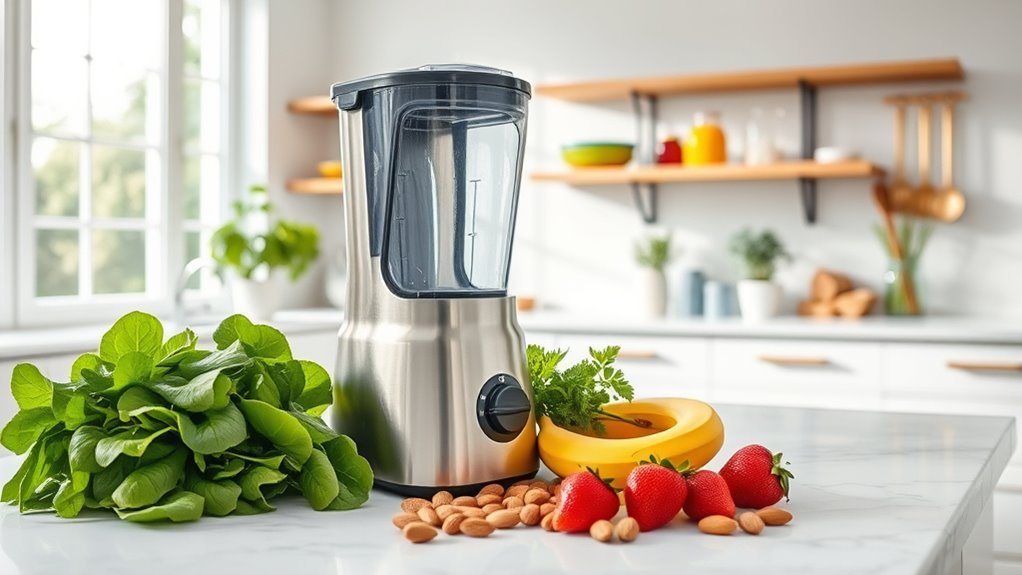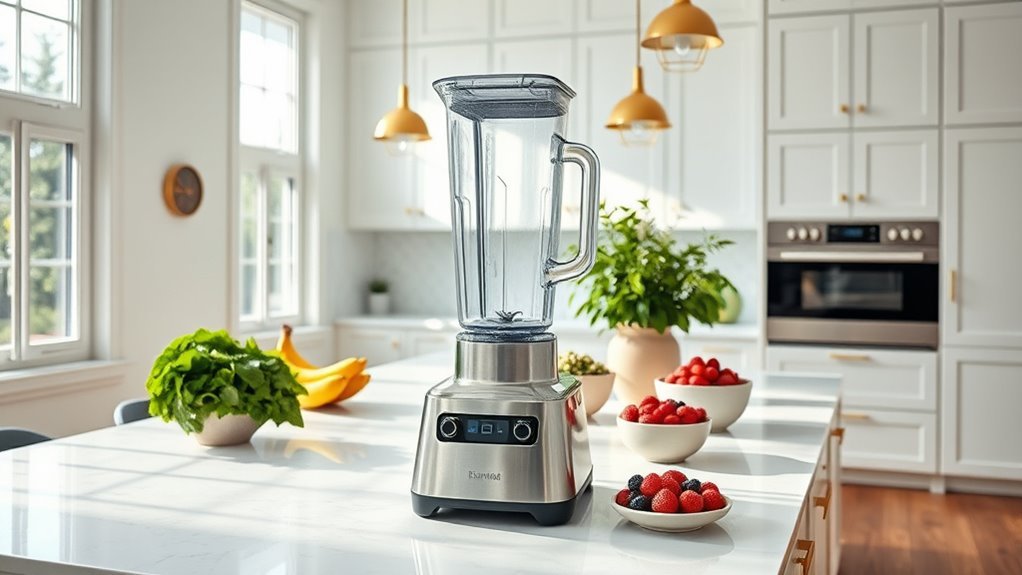For mixing, we’ll need either regular mouth (2.75″) or wide mouth (3.38″) Mason jars, with capacity choices from 8 to 32 ounces. Regular mouths excel with pourable ingredients like dressings, while wide mouths handle chunky mixtures better. Stick to pint jars for up to 2 cups and quart jars for up to 4 cups, but never fill past 80% capacity. The right jar choice dramatically impacts your mixing success – there’s more to this than meets the eye.
Understanding Mason Jar Dimensions and Capacities

Two key dimensions define your mason jar mixing capabilities: the 2.75-inch regular mouth and 3.38-inch wide mouth diameters.
We’ll tell you straight – jar sizes matter more than you think. Regular mouths excel with pourable ingredients, while wide mouth jars are your go-to for chunky stuff.
Let’s talk capacity: pint and quart size options give you mixing flexibility. A pint jar holds two cups – perfect for modest batches.
Need more room? Grab a quart jar for those bigger mixing projects.
Here’s the vital bit: never fill past 80% capacity. You’ll need that extra space for proper blending, trust us.
Remember, flat walls beat curved ones for thick mixtures, while curved jars handle liquids like a champ.
Pick your jar, respect its limits, and mix with confidence.
Matching Jar Sizes to Recipe Volumes
Selecting the right jar size isn’t just about storage – it’s about nailing your recipe volumes every time.
Let’s break it down so you’re never caught with the wrong container again.
For mixing up to 2 cups, grab a pint jar. It’s your perfect partner for everyday blending without the mess.
Need to whip up larger batches? A quart jar handles up to 4 cups like a champ.
Working with smaller portions? Half-pint jars are your go-to for individual servings and quick dips.
Here’s the golden rule: fill to 80% capacity, max. This gives your ingredients room to dance.
And when you’re tackling thick stuff like nut butter, stick to straight-sided jars – they’re absolute workhorses for proper mixing and easy cleanup. High-performance blenders can handle tough ingredients effortlessly, making them ideal for thicker mixtures.
Wide Mouth Vs Regular Mouth for Mixing

Every seasoned mixer knows that jar mouth size makes or breaks your blending game. Let’s cut through the confusion: wide mouth jars crush it for thick mixtures, while regular mouth jars excel with liquids.
| Feature | Wide Mouth | Regular Mouth |
|---|---|---|
| Opening | 3″ diameter | 2 ³⁄8″ diameter |
| Best For | Nut butters, chunks | Dressings, sauces |
| Mixing Ease | Superior access | Limited utensil fit |
We’re talking straight facts here: wide mouth jars give you that essential 3-inch opening for seamless mixing of chunky ingredients. Their straight sides? Game-changer for preventing stuck food. Regular mouth jars? They’re your go-to for smooth blends and precise pouring. Don’t fight your ingredients – match your jar to your mix. Additionally, high-performance blenders with large jar capacities can enhance your mixing experience by accommodating bigger batches effortlessly.
Optimal Fill Levels and Safety Margins
While precise measurements matter in mixing, your jar’s fill level can make or break the whole operation. We’ve found that 80% capacity hits the sweet spot for most blending needs, preventing lid explosions and ensuring ideal results.
Let’s be clear: jar sizes matter more than you’d think. Filling a large jar to just 20% is a rookie mistake – you’ll end up with ingredients plastered to the walls and potentially fried blades.
For thick mixtures like nut butters, we’ll need to push past that 80% mark, but keep an eye on the blending process. If those blades are spinning freely, you’re asking for trouble.
Here’s your safety check: monitor resistance during blending, use flat-walled jars for sticky stuff, and maintain ideal fill levels appropriate to your mixture.
Common Mixing Problems by Jar Size

Different jar sizes create distinct mixing headaches – and we’ve seen them all. Here’s what trips people up: Oversized jars leave too much empty space, causing ingredients to scatter instead of blend.
Meanwhile, cramped containers under 16 ounces can’t generate enough mixing momentum for thick substances like nut butter.
We’ve found pint jars hit the sweet spot for most mixing needs. But even these can cause problems if you’re not careful. Curved walls trap ingredients in hard-to-reach corners, while overfilling beyond 80% capacity turns mixing into a messy disaster.
The solution? Stick to straight-sided pint jars with flat walls for ideal blending.
And remember: regular mouth openings work best for pourable mixtures, giving you clean pours without the spills.
Special Considerations for Thick Ingredients
Since thick ingredients pose unique mixing challenges, flat-walled jars aren’t just a preference – they’re essential. We’ve found that straight-sided containers prevent sticky substances from getting trapped, ensuring every bit gets properly blended.
When you’re working with thick ingredients like nut butters or hummus, jar size matters more than you’d think. We recommend filling your container to at least 80% capacity – this prevents blade overheating and keeps everything moving smoothly.
Wide mouth jars are non-negotiable here; they’ll save you countless frustrations during both mixing and cleanup.
Think of it this way: undersized jars are like trying to stir cement with a toothpick. You need adequate space for proper resistance, or you’ll end up with overheated blades and uneven results.
Recommended Jar Sizes for Different Mixtures
Three essential jar sizes will handle nearly every mixing task you’ll encounter.
Regular mouth pint jars excel with smaller batches of dressings and sauces, giving you perfect control without mess. For thicker mixtures like nut butters and pestos, we’ll direct you to flat-walled quart jars – they’re non-negotiable for preventing ingredient buildup on the sides.
Wide mouth jars are your curved-wall champions, ideal for smoothies and batters where ingredients need room to move.
Whatever size you choose, remember our 80% rule: leave that vital space at the top for expansion. Trust us, you’ll thank us when your thick mixtures aren’t fighting for breathing room.
Bonus tip: wider mouths mean easier cleaning – a lifesaver when dealing with stubborn ingredients.
Frequently Asked Questions
What Can I Use 16 Oz Mason Jars For?
We can use 16 oz mason jars for soup storage, mixing salad dressings, or preparing overnight oats. They’re also perfect for storing dry goods, serving drinks, displaying flowers, and organizing craft supplies.
What Size Mason Jar Is Best for Drinks?
Like choosing the perfect cup, we’ll tell you 16 oz mason jars are best for drinks. They’re versatile for both hot and cold drink recipes, while offering practical jar alternatives to glassware.
What to Do With 32 Oz Mason Jars?
We can use 32 oz mason jars for DIY storage solutions, keeping pantry staples organized, crafting creative kitchen organization systems, or storing homemade sauces. They’re perfect for versatile crafting ideas too.
What to Can in 8 Oz Jars?
Let’s face it, we’re all jam-packed with canning dreams! Eight-ounce jars are perfect for our jelly recipes, sauce storage, and homemade preserves. They’re ideal for gifting too—because sharing is caring!
What Size Jar Should I Use for Pickling?
We recommend quart (32 oz) jars for most pickling projects. They’re perfect for the fermentation process, provide enough space for pickling spices, and are easy to sterilize before using.

